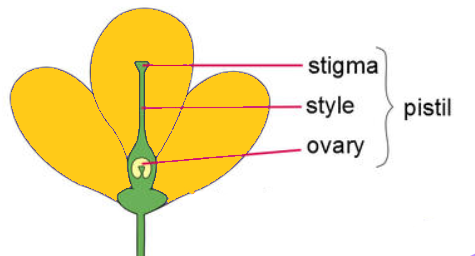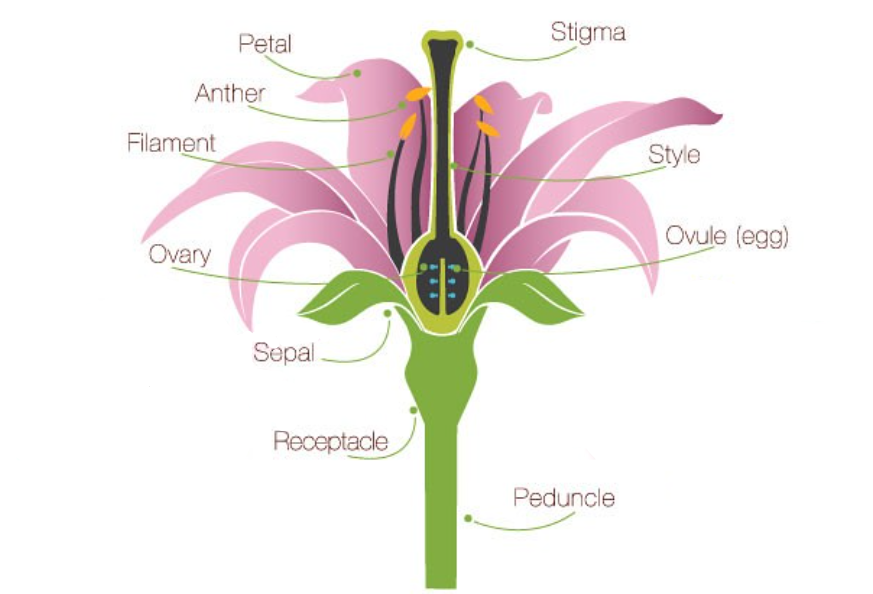
Name the various parts of the pistil.
Answer
495.9k+ views
Hint: Ovule producing part of the flowers known as pistil. On the top of stigma the ovary often supported by a long style and fruit is a part of the mature ovary. Pollen germination occurs in the part of the pistil known as stigma. The carpel, compound pistil, simple pistil and pistil lode is the other name of the pistil.
Complete answer:
Pistil consists of three parts:
> Stigma - It is a flat sticky top portion of pistil.
> Style - It is the stalk that expands below the stigma.
> Ovary - It is the swollen base containing ovules.

Additional information:
Bloom and blossom is the reproductive structure sometimes found in the plants. Angiosperms named after the magnoliophyta division of the plant. Pedicle is the part present in the stalk and at the tip forming the receptacle. Sepals is the outermost whorl consisting of the plant's units. Gamosepalous and polysepalous is the type of based fusion. Petals are also composed of units and color attract the insects that help the process of pollination.

Homochlamydeous, monochlamydeous, dichlamydeous, achlamydeous and chlamydias are the based on perianth that are present in the flowers. Androecium is the part that consists of stamens and apostemonous, diadelphous and monadelphous are the androecial type of fusion plants present in it. Gynoecium is the part that consists of carpels such as syncarpous, apocarpous based on the gynoecium type based on fusion. And campylotropous, anatropous and orthotropous are the Ovule types present in it.
Note: Stigma is present at the top sticky end which catches the pollen grain and connects to the ovary and ovaries help to produce the ovules. Pistil is the female part of the female and filament that support the anther is the male part of the. Plant. Ovule produced in the plants with the help of pistil.
Complete answer:
Pistil consists of three parts:
> Stigma - It is a flat sticky top portion of pistil.
> Style - It is the stalk that expands below the stigma.
> Ovary - It is the swollen base containing ovules.

Additional information:
Bloom and blossom is the reproductive structure sometimes found in the plants. Angiosperms named after the magnoliophyta division of the plant. Pedicle is the part present in the stalk and at the tip forming the receptacle. Sepals is the outermost whorl consisting of the plant's units. Gamosepalous and polysepalous is the type of based fusion. Petals are also composed of units and color attract the insects that help the process of pollination.

Homochlamydeous, monochlamydeous, dichlamydeous, achlamydeous and chlamydias are the based on perianth that are present in the flowers. Androecium is the part that consists of stamens and apostemonous, diadelphous and monadelphous are the androecial type of fusion plants present in it. Gynoecium is the part that consists of carpels such as syncarpous, apocarpous based on the gynoecium type based on fusion. And campylotropous, anatropous and orthotropous are the Ovule types present in it.
Note: Stigma is present at the top sticky end which catches the pollen grain and connects to the ovary and ovaries help to produce the ovules. Pistil is the female part of the female and filament that support the anther is the male part of the. Plant. Ovule produced in the plants with the help of pistil.
Recently Updated Pages
Master Class 12 Economics: Engaging Questions & Answers for Success

Master Class 12 Maths: Engaging Questions & Answers for Success

Master Class 12 Biology: Engaging Questions & Answers for Success

Master Class 12 Physics: Engaging Questions & Answers for Success

Master Class 4 Maths: Engaging Questions & Answers for Success

Master Class 4 English: Engaging Questions & Answers for Success

Trending doubts
Give 10 examples of unisexual and bisexual flowers

Draw a labelled sketch of the human eye class 12 physics CBSE

a Tabulate the differences in the characteristics of class 12 chemistry CBSE

Differentiate between homogeneous and heterogeneous class 12 chemistry CBSE

Why is the cell called the structural and functional class 12 biology CBSE

Differentiate between insitu conservation and exsitu class 12 biology CBSE




